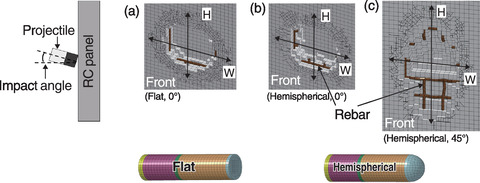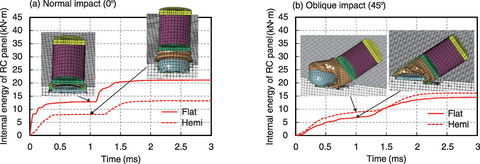
Fig.2-9 Local damage mode of RC panel

Fig.2-10 Numerical results for penetration damage to RC panel for cases (a) 1, (b) 2, and (c) 4

Fig.2-11 Time history of internal energy of RC panel
Table 2-1 Calculated height (H), width (W), and penetration depth (D) of damage in each case, in mm

As stipulated by the Nuclear Regulation Authority of Japan, nuclear facilities must be evaluated for their ability to withstand projectile impacts induced by tornadoes or aircraft. These evaluations must comprise the resulting local damage to the area of collision (Fig.2-9), the overall response of nuclear facility buildings, and the influence of vibrations propagating along the wall or floor on any internal equipment. As part of this ongoing effort, the work summarized here focused on evaluating the local damage to a building's outer wall made of reinforced concrete (RC) under various impact conditions.
Local damage to an RC plate-shaped structure, or RC panel, can be categorized as penetration, scabbing, or perforation. Various empirical formulas depending on the damage mode have been developed to evaluate the local damage suffered by RC panels subjected to normal impact by rigid projectiles, i.e., projectiles impacting at an angle of 0° and assumed to not undergo any deformation during impact. However, this assumption is not valid for many possible projectiles; an evaluation method taking into account realistic impact conditions relevant to projectiles capable of deforming and absorbing energy at the time of collision, such as airplanes, was thus developed.
First, the finite element method was used to simulate the local damage of an RC panel representing the outer wall of a nuclear facility building, where a flat projectile that is regarded as a scaled engine model was used to impact the RC panel at a normal angle. The proposed numerical method was validated with experimental results. This validated model was then used to examine the penetration damage under various impact conditions, including different nose shapes (i.e., flat or hemispherical) and impact angles (i.e., normal, 0°, or oblique, 45°), as detailed in Table 2-1. The results, summarized in Table 2-1 and Fig.2-10, show that under oblique impact, the damage area of the RC panel tends to be longer and broader. However, different nose shapes did not significantly vary the damage dimensions.
Because damage had occurred inside the RC panel as well, the internal energy was analyzed. Under normal impact, the internal energy of the RC panel after impact with a hemispherical projectile was 40% lower than after impact with a flat projectile. The buckling of the hemispherical nose may have led to a part of the impact energy being absorbed, thus reducing the internal energy of the RC panel. Under oblique impact, the internal energy of the RC panel was similar using either nose shape. After impact with the flat projectile, the internal energy of the RC panel under oblique impact was about 30% lower than that under normal impact, whereas the impact angle of the hemispherical projectile had only a minor effect on the internal energy of the RC panel (Fig.2-11).
These results provide a technical background for evaluating local damage to RC panels subjected to projectile impact under realistic conditions. Future efforts will include expanding the model to analyze the overall response of the building and evaluate the effects of impact vibrations on internal equipment.
(Zuoyi Kang)